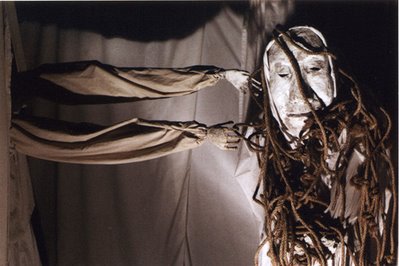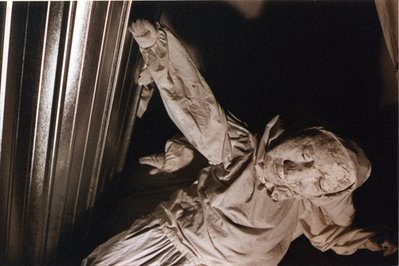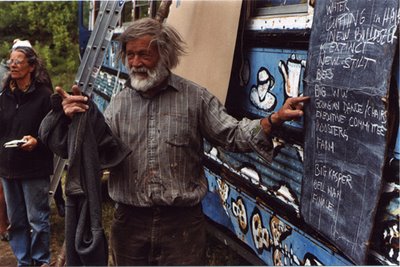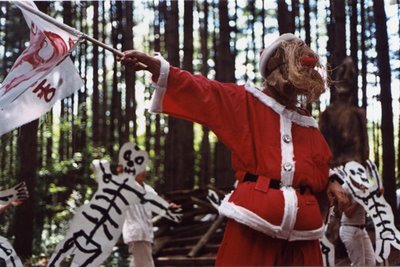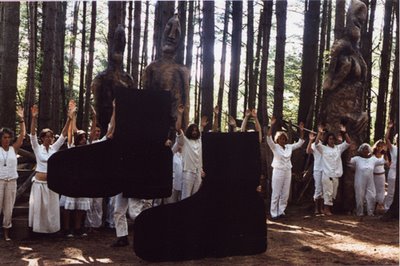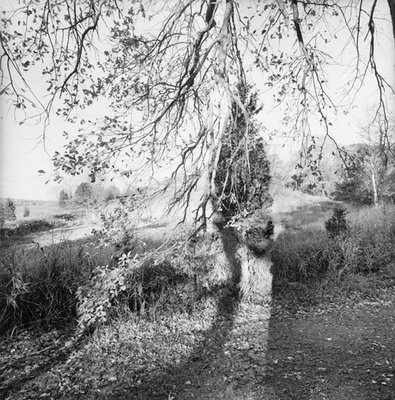Ian Thal on Peter Schumann
Last year, Bread and Puppet Theater founder Peter Schumann sparked a small stir at the Boston Center for the Arts and later a larger stir in Burlington, Vermont, when he exhibited paintings protesting what he sees as Israeli oppression of Palestinians, matched with passages from John Hersey’s 1950 novel "The Wall" about the Nazi extermination of Warsaw ghetto Jews during World War II. Schumann says his theme was an “oppressed people who oppresses a people.” Critics charged that Schumann was equating Israelis today with Nazis, which he says “wasn’t my intent.”
Below are edited excerpts from an e-mail conversation I had with Somerville performer Ian Thal, one of the most outspoken critics of Schumann’s paintings last year, who has posted much about the matter to his blog, including charges of anti-Semitism against Schumann. I’m posting both Schumann’s (see here and here) and Thal’s comments to document the range of the issues and the dispute. These posts are not endorsements of either man’s views. (For a more complete introduction to the issue see here.)
NEJAR: What are your feelings about Bread and Puppet – and Peter Schumann – now?
Thal: He is a great and innovative artist who lives in denial regarding extremist politics, anti-Semitism, terrorism, and the legacy of the Third Reich. I've come to see him almost as a Leni Riefenstahl figure. Though I think he's a better artist.
I'm left to wonder how much of this is a hangover from the Nazi propaganda he was fed as a child of the Reich – which I note, is a subject he cleverly skirts around in interviews – In his nostalgia for Silesia he never mentions Hitler or that Silesia contained the site of the largest mass murder in history: Auschwitz-Birkenau. He only talks about his happy childhood being interrupted by Allied bombing and post-WWII redrawing of borders.
Indeed, at last year's talk at the BCA he avoided mentioning that the Germans had anything to do with the Warsaw Ghetto – instead blaming the Jews for not reaching out to their Polish neighbors. This is untrue if one reads any historical account of the Warsaw Ghetto Uprising: the Jewish Combat Organization and Jewish Military Union received arms and assistance from the Polish Home Army, the Polish Communist People's Guard, and unaffiliated Partisans: all of whom sent troops in to battle the German and Ukrainian forces and their Polish collaborators during the Uprising.
Schumann says the theme of his paintings last year – and, I take it, the wall part of last year's BCA performance – was an "oppressed people who oppresses a people." He says it "wasn't my intent" to equate Israelis today with Nazis. What's your sense of this?
My sense is that he is dissimulating. Note that he only denies it was his intent when responding to criticism, when his defenders see the equation and vocally claim some equivalence between Israel and the Third Reich, he has been silent and does not try to correct them. Even after it was obvious how the work was being interpreted, he continued to exhibit the work.
If his intent was not to equate Israelis with Nazis then he would have picked very different images. He's 73 years old and has a wide palette of iconography from which he could choose. He deliberately chose the icons for their divisiveness. He doesn't have the excuse of youthful naiveté.
Remember, living with a legitimate fear that someone you love will be blown up just for riding the bus, or for going out for a slice of pizza is oppression as well. But Schumann doesn't want to see that part of the equation, in fact, this appears to be an ongoing trend theme in his recent work to belittle the suffering caused by terrorist actions.
The West Bank wall is the most effective non-lethal means Israel had of preventing suicide bombers. No suicide bombers means no Israel Defense Forces reprisals. So both Israeli and Palestinian lives were saved, and Palestinians have been able to rebuild after the destruction caused by what some call the "Al Asqa Intifada." The other option would be to allow a cycle of violence to continue – I don't think more dead Jews and more dead Arabs helps anyone but the extremists.
By contrast, the walled in ghettos created by Germany, were a deliberate attempt to destroy European Jewery – time caused the death of five to six hundred thousand people – roughly 20 percent of the Jewish population of Poland died inside those ghetto walls in roughly two years time. Nothing remotely similar has occurred in Israel or Palestine.
One of the questions this all raises is how can we ever discuss Israeli-Palestinian problems?
We need to make our best efforts to speak carefully and truthfully about the situation as it stands and to also understand the historical forces that created this situation. Schumann's statements in person and in interviews leads me to conclude that he has no interest in either endeavor, only creating propaganda. How can you have a serious discussion with someone who is morally unserious?
Seriously speaking, Israel, though often deserving of criticism, still has the best human rights record of any nation in the Middle East and certainly makes a greater effort to comply with international law than the United States or United Kingdom have done in the region.
Ian Thal performs “An evening of mime, poetry and masks” at 8 tonight, Saturday, Feb. 9, 2008, at Willoughby and Baltic Gallery, 195g Elm St., Somerville.
Below are edited excerpts from an e-mail conversation I had with Somerville performer Ian Thal, one of the most outspoken critics of Schumann’s paintings last year, who has posted much about the matter to his blog, including charges of anti-Semitism against Schumann. I’m posting both Schumann’s (see here and here) and Thal’s comments to document the range of the issues and the dispute. These posts are not endorsements of either man’s views. (For a more complete introduction to the issue see here.)
NEJAR: What are your feelings about Bread and Puppet – and Peter Schumann – now?
Thal: He is a great and innovative artist who lives in denial regarding extremist politics, anti-Semitism, terrorism, and the legacy of the Third Reich. I've come to see him almost as a Leni Riefenstahl figure. Though I think he's a better artist.
I'm left to wonder how much of this is a hangover from the Nazi propaganda he was fed as a child of the Reich – which I note, is a subject he cleverly skirts around in interviews – In his nostalgia for Silesia he never mentions Hitler or that Silesia contained the site of the largest mass murder in history: Auschwitz-Birkenau. He only talks about his happy childhood being interrupted by Allied bombing and post-WWII redrawing of borders.
Indeed, at last year's talk at the BCA he avoided mentioning that the Germans had anything to do with the Warsaw Ghetto – instead blaming the Jews for not reaching out to their Polish neighbors. This is untrue if one reads any historical account of the Warsaw Ghetto Uprising: the Jewish Combat Organization and Jewish Military Union received arms and assistance from the Polish Home Army, the Polish Communist People's Guard, and unaffiliated Partisans: all of whom sent troops in to battle the German and Ukrainian forces and their Polish collaborators during the Uprising.
Schumann says the theme of his paintings last year – and, I take it, the wall part of last year's BCA performance – was an "oppressed people who oppresses a people." He says it "wasn't my intent" to equate Israelis today with Nazis. What's your sense of this?
My sense is that he is dissimulating. Note that he only denies it was his intent when responding to criticism, when his defenders see the equation and vocally claim some equivalence between Israel and the Third Reich, he has been silent and does not try to correct them. Even after it was obvious how the work was being interpreted, he continued to exhibit the work.
If his intent was not to equate Israelis with Nazis then he would have picked very different images. He's 73 years old and has a wide palette of iconography from which he could choose. He deliberately chose the icons for their divisiveness. He doesn't have the excuse of youthful naiveté.
Remember, living with a legitimate fear that someone you love will be blown up just for riding the bus, or for going out for a slice of pizza is oppression as well. But Schumann doesn't want to see that part of the equation, in fact, this appears to be an ongoing trend theme in his recent work to belittle the suffering caused by terrorist actions.
The West Bank wall is the most effective non-lethal means Israel had of preventing suicide bombers. No suicide bombers means no Israel Defense Forces reprisals. So both Israeli and Palestinian lives were saved, and Palestinians have been able to rebuild after the destruction caused by what some call the "Al Asqa Intifada." The other option would be to allow a cycle of violence to continue – I don't think more dead Jews and more dead Arabs helps anyone but the extremists.
By contrast, the walled in ghettos created by Germany, were a deliberate attempt to destroy European Jewery – time caused the death of five to six hundred thousand people – roughly 20 percent of the Jewish population of Poland died inside those ghetto walls in roughly two years time. Nothing remotely similar has occurred in Israel or Palestine.
One of the questions this all raises is how can we ever discuss Israeli-Palestinian problems?
We need to make our best efforts to speak carefully and truthfully about the situation as it stands and to also understand the historical forces that created this situation. Schumann's statements in person and in interviews leads me to conclude that he has no interest in either endeavor, only creating propaganda. How can you have a serious discussion with someone who is morally unserious?
Seriously speaking, Israel, though often deserving of criticism, still has the best human rights record of any nation in the Middle East and certainly makes a greater effort to comply with international law than the United States or United Kingdom have done in the region.
Ian Thal performs “An evening of mime, poetry and masks” at 8 tonight, Saturday, Feb. 9, 2008, at Willoughby and Baltic Gallery, 195g Elm St., Somerville.





